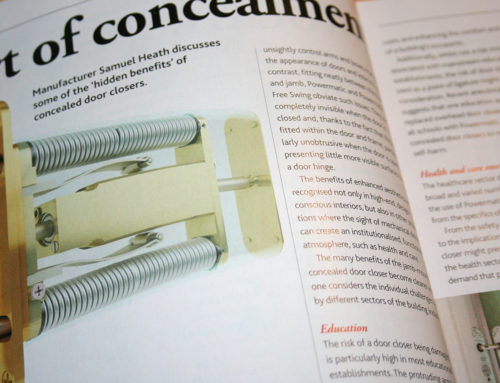If you are in the business of marketing to architects, there are a number of factors that need to be considered in order to achieve your desired results. Here we give an insight into the role the architect plays, the reasons they choose products and how building materials manufacturers can influence the specification process:-
Why are architects so important?
On any building project the architect is probably the most important member of the design team. They play an important part in listening to, filtering and coming up with solutions that meet the requirements and advice of everyone else involved in the project.
They start by considering the client’s needs in terms of how the building will be used and how the client wishes to be perceived. These needs must then be developed around the requirements of Building Regulations, sustainability and other compliance requirements. Finally, they take into account the views and advice of quantity surveyors, the main contractor and specialist sub-contractors as these will often be well-positioned to suggest ways of saving time, money and environmental impact.
Research suggests that on the majority of small to medium building projects, architect specified products usually go through to final installation unchallenged. The specification for large projects is more complex, with contractors and sub-contractors involved in the final choices.
When does an architect want to work with a new supplier?
If your organisation is aiming to find new customers for your products, amongst architects it is important to consider the possible scenarios that would mean an architect is looking for a new supplier. This is likely to be for two main reasons:
- When something goes badly wrong with the existing supplier.
- When the existing supplier doesn’t, or can’t, supply what they need.
It is generally true that no-one likes change for the sake of it. The most likely reason for change is that someone in the project team no longer wants or likes what they already have. This means that you need to look at your competitors and see what they aren’t delivering – then consider carefully how you can provide something your competitors aren’t.
How do architects find a new supplier?
Assuming that a product meets the necessary criteria (performance, aesthetics, quality, etc.) and is suitable for a project, an architect is likely to make decisions on a new supplier based on personal recommendation and then internet research, internet research then personal enquiries or familiarity (brand/company awareness) and internet research.
Search engines, product directories and manufacturers’ websites all provide useful data and, increasingly, new forms of communication are being turned to such as blogs and even Twitter.
Most of their choices are going to rely upon some sort of existing relationship – someone they know and trust – so the key action for you is to build relationships. This might be a relationship that has developed through interaction with your company (representative visits, presentations, forums, blogs, etc.) or indirect contact through your own promotional activities (advertising, PR, etc.)
Social media is now becoming a vital part in developing these relationships. The idea that social media platforms such as Twitter, Facebook and LinkedIn are somehow separate from the real professional world is a misconception and could lead to a potential wasted opportunity.
Social media, or any platform with an interactive, conversational element, is a direct extension of the personal face-to-face service that companies have been providing for decades. The big differences with social media are; that you can do it far more quickly and effectively (especially making first contact or keeping in touch between meetings), that some of it is conducted in public, and that the architect, or any other professional, can enter into this relationship anonymously if desired.
Many architects and other construction professionals actively use Twitter as a serious business tool. To see it as unprofessional is a mistake. You shouldn’t be put off by the doubters who suggest that people will be overwhelmed. They’ve misunderstood its purpose – social media platforms are about searching not browsing, so professionals can find information that is specific to their area of interest, and can choose whether or not to receive information as well as filtering it quickly.
So, you, your company and your client-facing staff should be on social networking sites.
Architects who happen to find your website or blog can then Google you to find where else you are. They can go on LinkedIn, find some of your people, and see whether they know anyone who knows them. They can discretely (anonymously even) examine your activity on Twitter to see what you are talking about and who you’re talking to – they might be someone they know. Then they can call, email or message that person to gather information about you and your products.
Key considerations for your marketing activity
The process of selecting products for a project is complex, with many different factors coming to bear on the decision-making; aesthetics, performance, reliability, quality, technical support, et.
To make the right decisions the architect is going to need high quality information. Therefore, it is important that you make your information easy to find, access and understand. To stand out you need to keep the message clear, precise and with minimal or, ideally, no commercial hyperbole.
Make sure that you convey what is unique about your offering; why they should choose you above the competition. Include all the technical performance information you can and, if possible, any independent testing results. For architects, a sophisticated audience with a strong sense of aesthetics, high quality imagery and presentation is a must.
You will also need to keep gently reminding them about you and your products over time…
Some strategies worth considering
In addition to any social media activity that you decide to undertake, there are other methods of keeping your name in front of architects:-
CPD seminars – introduce your company and demonstrate your technical expertise. Methods of delivery can vary from personal presentations to seminars delivered via the internet or interactive ‘courses, constantly available on your website.
Personal presentations and internet delivered seminars have the benefit of enabling you to meet (even if it is via broadband) several architects at the same time, which can often lead to a discussion about specific projects.
To be effective the seminar must have the correct content, with minimal, if any, commercial messaging, and be well-presented.
Direct marketing – via email or post is a tried and tested means of reaching a defined target audience. It will produce results, but only if you have the right database to work with; out of date information will be a waste of time and money.
Case studies – in trade and technical magazines (and websites) will create awareness and interest, especially if written in the right way and properly presented.
Display advertising in professional publications – worthy of consideration (Architects Journal, Architecture Today, RIBA Journal, etc.), but consider whether the publication is valued by the people you want to reach and so more likely to be read – there has been a proliferation of architectural magazines (and websites) in recent years, but few carry weight in the architectural community and are, therefore, unlikely to be read by the people you want to reach.
Also be aware that your competitors will be present alongside you. Select the media carefully and ensure that your message will be seen, read and remembered.
Reference systems – online and in print, architectural and specification reference systems, such as RIBA Product Selector and Barbour, generally present your information in an objective fashion so that it can be easily and quickly assimilated by the architect. They can be expensive and, again, careful consideration needs to be given to the system(s) used as well as the content of your information, which needs to present data that is useful to the architect in making their decisions.
In summary
As with any target audience, architects can be reached through a number of different activities. The most effective strategy will be to employ a combination of all techniques in a co-ordinated fashion so that each activity supports the other.
In everything you do, try to appreciate what makes an architect tick, what they need to do their job and what tools (media) they use. Engage with them at their level, present your products and company in a fashion that meets these criteria and you will be on the road to success.





